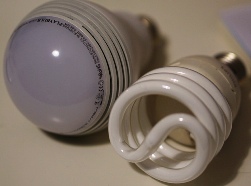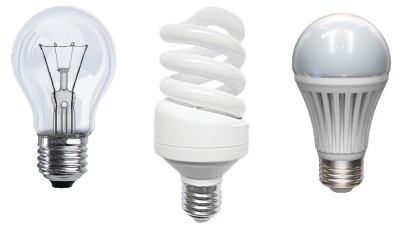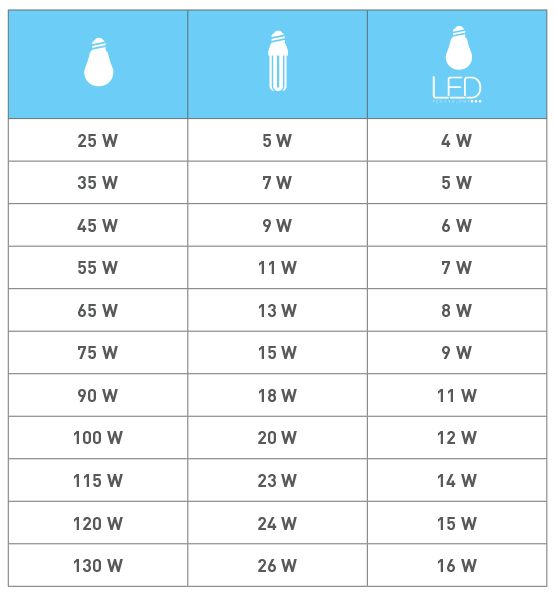Categories: Sources of light, Energy saving
Number of views: 33912
Comments on the article: 10
The ratio of the power of lamps of various types
 The range of lamps today is quite wide, and it is not at all surprising that someone may have difficulty choosing lamps. Someone still uses incandescent lamps, while someone has already switched to more economical compact fluorescent and LED lamps. Meanwhile, Federal Law No. 261 “On Energy Saving” significantly limits the possibility of using incandescent lamps in the future.
The range of lamps today is quite wide, and it is not at all surprising that someone may have difficulty choosing lamps. Someone still uses incandescent lamps, while someone has already switched to more economical compact fluorescent and LED lamps. Meanwhile, Federal Law No. 261 “On Energy Saving” significantly limits the possibility of using incandescent lamps in the future.
In order to help the consumer make the right choice, we compare the power of various types of lamps. Let us consider how the power of an incandescent lamp, a compact fluorescent lamp, and an LED lamp correlate with approximately equal requirements for the luminous flux emitted by them.
We will compare the following three lamps:
-
A 75 W incandescent lamp with a declared luminous flux of 935 Lm;
-
A compact fluorescent lamp with a power of 15 W with a declared luminous flux of 1000 Lm;
-
9 W LED lamp with a declared luminous flux of 800 Lm.

Recall that the luminous flux is called one of the main parameters of the light source, which determines the power of the directly emitted light. The luminous flux in lumens (Lm) is measured.
Measurements to evaluate the light of lamps in order to correlate their power are carried out with a light meter. Light meter shows illumination, that is, the ratio of the light flux emitted by the lamp to the unit area illuminated by the lamp. So 1 lux (Lx) is equal to 1 lumen per 1 square meter. The number of lux determines the intensity of the light, that is, the direct illumination.

For the experiment to determine the ratio of the power of the lamps, the table surface was chosen under the lamp, at a distance of 65 cm from it. The lamps were supplied with an alternating voltage of 220 volts.
Light meter measurement results:
-
75 W incandescent lamp - 560 Lux;
-
Compact fluorescent lamp (CFL) with a power of 15 W - 389 Lx;
-
9 W LED lamp - 611 Lux.
According to the results of measurements with a light meter, it is easy to see that the illumination is highest for the LED lamp, then there is an incandescent lamp, and, finally, a compact fluorescent lamp. Nevertheless, the power ratio is obviously in favor of the LED lamp, then comes the compact fluorescent lamp, and the incandescent lamp is the least efficient.
Since the luxmeter was measured in this experiment from the same distance, for the most objective assessment, we calculate the Lux / Watt ratio for each of the lamps, since the Lux / Watt ratio in this case is directly related to the Lumen / Watt ratio, i.e., with light output:
-
Incandescent lamp with a power of 75 W - 7.46 Lux / Watt;
-
Compact fluorescent lamp (CFL) with a power of 15 W - 25.93 Lux / Watt;
-
9 Watt LED Bulb - 67.88 Lux / Watt.
From the experimental data, we can conclude the relative effectiveness of the three lamps considered:
-
LED lamp is 2.6 times more effective than a compact fluorescent lamp and 9 times more effective than an incandescent lamp;
-
A compact fluorescent lamp is 3.5 times more effective than an incandescent lamp, but 2.6 times inferior to an LED lamp.
-
An incandescent lamp is 3.5 times less effective than CFL, and 9 times less effective than LED.
Obviously, the LED lamp turns out to be the most effective, with a minimum power it gives better illumination. A compact fluorescent lamp is more effective than an incandescent lamp, but do not forget that such lamps contain mercury and require a special approach to disposal. And incandescent lamps rightly turn out to be a relic of the past, their efficiency is very low.
As a result, we can conclude that at the moment the best in terms of power consumption and light output LED lamp.
Comparison of the power of light bulbs made by various technologies (incandescent, compact fluorescent and LED):

See also at bgv.electricianexp.com
:
